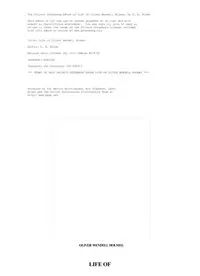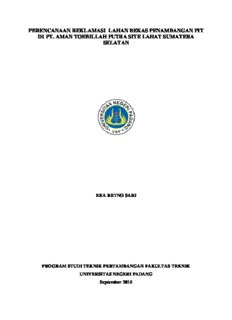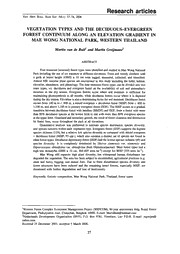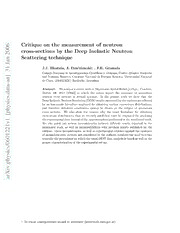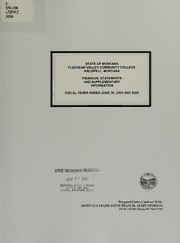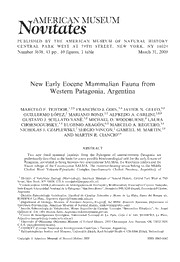
New Early Eocene Mammalian Fauna from Western Patagonia, Argentina PDF
Preview New Early Eocene Mammalian Fauna from Western Patagonia, Argentina
PUBLISHED BY THE AMERICAN MUSEUM OF NATURAL HISTORY CENTRAL PARK WEST AT 79TH STREET, NEW YORK, NY 10024 Number 3638, 43 pp., 10 figures, 1 table March 31, 2009 New Early Eocene Mammalian Fauna from Western Patagonia, Argentina MARCELO F. TEJEDOR,1,2,8 FRANCISCO J. GOIN,3,8 JAVIER N. GELFO,3,8 GUILLERMO LO´PEZ,3 MARIANO BOND,3,8 ALFREDO A. CARLINI,3,8,9 GUSTAVO J. SCILLATO-YANE´,3,8 MICHAEL O. WOODBURNE,4 LAURA CHORNOGUBSKY,5,8 EUGENIO ARAGO´N,6,8 MARCELO A. REGUERO,3,8 NICHOLAS J. CZAPLEWSKI,7 SERGIO VINCON,2 GABRIEL M. MARTIN,2,8 AND MARTI´N R. CIANCIO3,8 ABSTRACT Two new fossil mammal localities from the Paleogene of central-western Patagonia are preliminarilydescribedasthebasisforanewpossiblebiochronologicalunitfortheearlyEoceneof Patagonia,correlatedasbeingbetweentwoconventionalSALMAs,theRiochican(older)andthe Vacan subage of the Casamayoran SALMA. The mammal-bearing strata belong to the Middle Chubut River Volcanic-Pyroclastic Complex (northwestern Chubut Province, Argentina), of 1Division of Vertebrate Zoology (Mammalogy), American Museum of Natural History, Central Park West at 79th Street,NewYork,NY10024,U.S.A.(mtejedor@unpata.edu.ar). 2Currentaddress:LIEB(LaboratoriodeInvestigacionesenEvolucio´nyBiodiversidad),FacultaddeCienciasNaturales, SedeEsquel,UniversidadNacionaldelaPatagonia‘‘SanJuanBosco’’,Sarmiento849,9200Esquel,ProvinciadelChubut, Argentina. 3Divisio´n Paleontolog´ıa Vertebrados, Facultad de Ciencias Naturales y Museo de La Plata, Paseo del Bosque s/n, B1900FWALaPlata,Argentina(fgoin@fcnym.unlp.edu.ar). 4Department of Geology, Museum of Northern Arizona, Flagstaff, AZ 86001. Research Associate, Department of VertebratePaleontology,AmericanMuseumofNaturalHistory,(mikew@npgcable.com). 5Seccio´nPaleontolog´ıadeVertebrados,MuseoArgentinodeCienciasNaturales‘‘BernardinoRivadavia’’,Av.Angel Gallardonu470,1405BuenosAires,Argentina(lchorno@macn.gov.ar). 6Centro de Investigaciones Geolo´gicas, Universidad Nacional de La Plata, Calle 1 nu 644, B1900FWA La Plata, Argentina(earagon@cig.museo.unlp.edu.ar). 7UniversityofOklahoma,OklahomaMuseumofNaturalHistory,2401ChautauquaAve,Norman,OK73072-7029, U.S.A.(nczaplewski@ou.edu). 8CONICET(ConsejoNacionaldeInvestigacionesCient´ıficasyTe´cnicas,Argentina). 9Pala¨ontologischesInstitutundMuseum,UniversitaˆtZu¨rich,KarlSchmid-Straße4,CH-8006Zu¨rich,Switzerland. CopyrightEAmericanMuseumofNaturalHistory2009 ISSN0003-0082 2 AMERICAN MUSEUMNOVITATES NO. 3638 Paleocene-Eoceneage.Thiscomplexincludesavarietyofvolcaniclastic,intrusive,pyroclastic,and extrusive rocks deposited after the K-T boundary. Geochronological data taken from nearby volcanicdepositsthatunderlieandoverliethemammal-bearinglevelsindicatethatbothfaunasare of late early Eocene age (Ypresian-Lutetian boundary). In addition to more than 50 species of mammals, including marsupials, ungulates, and xenarthrans, two lower molars are the oldest evidence of bats in South America. Paleobotanical and palynological evidence from inferred contemporary localities nearby indicate subtropical environments characterized by warm and probably moderately humid climate. Remarkably, this new fauna is tentatively correlated with EocenemammalsfromtheLaMesetaFormationintheAntarcticPeninsula.Weconcludethatthe two localities mentioned above are part of a possible new biochronological unit, but the formal proposal of a new SALMA awaits completion of taxonomic analysis of the materials reported uponhere.IftheLaMesetafaunaiscorrelatedbiochronologicallytowesternPatagonia,thisalso suggestsacontinentalextensionofthebiogeographicWeddelianProvinceasfarnorthascentral- western Patagonia. INTRODUCTION magnetic polarity stratigraphy from Gran Barranca indicated a much younger age than The past two decades have seen an increase previously recognized for the Barrancan sub- in the number of studies on the evolution age levels, with an age ranging from 37.60– of Paleogene South American mammals. 35.69 Ma (Kay et al., 1999). This indicates Consequently, knowledge of their taxonomy, thattheBarrancanisoflateEoceneage.More biostratigraphy, biogeography, and geochro- recent calibrations indicated an age of about nologyhasbeensubstantiallyimproved.Asan 38.5 Ma for the upper boundary of the example, the biochronological sequence for Barrancan levels, and 41.5 Ma for the base the South American Paleogene showed no (Madden et al., 2005). There are no published relevant changes from 1948 through the datesforsedimentsdepositedduringtheolder, middle 1980s (Simpson, 1948; Marshall et ‘‘Vacan’’ subage of the Casamayoran, al- al., 1983; Pascual et al., 1965, Patterson and though Carlini et al. (2005: fig. 1) suggested Pascual, 1972). Subsequent taxonomic, geo- a time interval of ca. 44–45 Ma for it. chronological, and biostratigraphic studies These new findings represent a major have contributed greatly in improving our change regarding South American biochro- understanding of the faunal evolution and nology. During most ofthe second half ofthe succession of South American mammals 20th century, the Casamayoran (Barrancan (Flynn and Swisher, 1995, and references plus Vacan) SALMA was regarded as early therein;Pascualetal.,1996).Thishasresulted Eocene (e.g., Simpson, 1935b). Thus, the in the identification of nearly 20 South above-mentioned revisions have left a faunal American Land Mammal Ages (SALMAs). gap in the early Eocene record of South Land Mammal Ages have been recognized as American mammals. This gap is partially biochronological units (Pascual et al., 1965; filled by the new faunas from the Chubut Woodburne, 1977; Archibald et al., 1987; River region, discussed below. Pascual and Ortiz Jaureguizar, 1990). Lower in the Paleogene sequence, the OneofthemostrecentrenovationsinSouth uppermost Salamanca Formation and the American biostratigraphy was the revision whole R´ıo Chico Group (Legarreta and and isotopic calibration of the Casamayoran Uliana, 1994) are present in several localities SALMA. The Casamayoran was previously of Chubut and Santa Cruz provinces, where consideredanearlyEocenemammalrecordin theyunderlietheSarmientoGroup.Theyhave South America (55–50 Ma; Marshall et al., long been considered Paleocene in age 1983). Cifelli (1985) divided the Casamayoran (Simpson, 1948, 1967a, b). Marshall et al. into two subages: Vacan, the older, and (1981) correlated the Hansen Member Barrancan, the younger. Recently, the geo- (‘‘Banco Negro Inferior’’) of the Salamanca chronology of the Casamayoran SALMA has Formation (Andreis et al., 1975), and the been revised at the locality of Gran Barranca overlying sediments of the R´ıo Chico Group (Barrancan subage), south-central Chubut with Chron 26r, which corresponds to a Province. Several 40Ar/39Ar dates as well as temporal range between 61.70 6 0.2 and 2009 TEJEDOR ET AL.: EOCENEMAMMALS FROMWESTERN PATAGONIA 3 58.70 6 0.2 Ma (Gradstein et al., 2004). SALMA, there seems to be an impressive 10 However, two localities of the Banco Negro million year time gap between them—i.e., Inferior have been correlated with Chron 27r 55 Ma for the top of the Riochican, and (Somoza et al., 1995), i.e., between 63.20 and 45 Ma for the base of the Vacan. Ongoing 62.0 Ma (Gradstein et al., 2004). Because of work addresses this ‘‘black hole’’ in our the original correlation with the Paleocene knowledge of the South American Paleogene faunas of the Bolivian locality of Tiupampa faunalsuccessionsintwoways:first,wereview (Muizo´n,1991),theBancoNegroInferiorwas the previously inferred ages for the whole R´ıo originallyassignedtotheTiupampanSALMA Chico succession (Raigemborn et al., in prep- (Pascual and Ortiz Jaureguizar, 1990). How- aration);second,weareprospectingPaleogene ever, Bonaparte et al. (1993) named the new levelsoutsidetheSanJorgeGulfregion(which Peligran SALMA on the basis of the distinct containsnofossiliferouslevelsrepresentingthis mammal assemblage present there. Relative timegapascurrentlyknown). agesofthePeligranandTiupampanSALMAs The present work represents the first of a have been under intense debate (see Pascual series of contributions that propose a new and Ortiz Jaureguizar, 1990; Bonaparte et al., approach to the problem. Here we describe 1993; Gelfo, 2006). two fossil mammal localities of late early Above the Salamanca Fm. various levels of Eocene age from western Patagonia, filling the R´ıo Chico Group crop out, mostly in partofthecurrentearlytomiddleEocenegap southeastern Chubut and in northeastern in the South American fossil record. On the Santa Cruz provinces. Simpson (1935b) rec- basis of these localities, we suggest they may ognized ‘‘faunal zones’’ in the region of San represent a new biochronological unit, one of Jorge Basin, southeastern Chubut Province, themostdiversemammalianfaunasknownup representing distinct faunal episodes in the to now from South America. early Tertiary: from oldest to youngest these werethe‘‘Carodniafaunalzone’’,the‘‘Kibeni- ABBREVIATIONS AND TERMINOLOGY khoria faunal zone’’, and the ‘‘Ernestokokenia faunalzone’’.LegarretaandUliana(1994;see LIEB-PV, Laboratorio de Investigaciones also Bond et al., 1995) presented a new en Evolucio´n y Biodiversidad–Vertebrate lithostratigraphy naming the formations Paleontology Collection, Facultad de Cien- Pen˜as Coloradas, Las Flores, and Koluel cias Naturales, Sede Esquel, Universidad Kaike, respectively, corresponding to the Nacional de la Patagonia ‘‘San Juan Bosco’’; already mentioned faunal zones. Following MLP, Museo de La Plata; AMNH, American Bond et al. (1995), these episodes represent at Museum of Natural History. The dentition is least three discrete SALMAs, from oldest to referredwiththelettersi/I,c/C,p/P,andm/M youngest, a post-Tiupampan or post-Peligran for lower and upper incisors, canines, premo- SALMA, Itaboraian (Kibenikhoria faunal lars, and molars, respectively, followed by the zone, Las Flores Formation and locality), correspondingnumber,whilean‘‘x’’refertoa and Riochican (Ernestokokenia faunal zone), tooth of uncertain position. leaving the Carodnia faunal zone as a fourth episode between the Peligran and Itaboraian, GEOGRAPHIC SETTING poorlyunderstoodandnotsufficientlyknown to justify naming a new SALMA. The The new fossiliferous localities, named suggested age for the Riochican SALMA Laguna Fr´ıa and La Barda, are the western- was between 58.5 and 55 Ma (Pascual and most Paleogene mammal-bearing sites in Ortiz Jaureguizar, 1991). An important limi- Patagonia. They are located in northwestern tation—as noted byBond etal. (1995)—isthe ChubutProvince,Argentina,nearthetownof difficulty of recognizing these SALMAs out- Paso del Sapo, along the south side of the side the region, even elsewhere in Patagonia. middle Chubut River (fig. 1). The area is In brief, taking into account the inferred surrounded by the Sierras de Huancache numericalagesfortheRiochicanSALMAand (northeast), Sierras de Cutancunue´ (south), the Vacan subage of the Casamayoran and Sierras de Taquetre´n (east). 4 AMERICAN MUSEUMNOVITATES NO. 3638 Fig. 1. Location map showing both fossiliferous localities of Paso del Sapo and the remaining known PaleogenelocalitiesofcentralPatagoniadiscussedinthetext.1.LagunaFr´ıa;2.LaBarda;3.LasFlores;4. Gran Barranca; 5. Can˜ado´n Vaca; 6. Can˜ado´n Hondo; 7. Bajo Palangana; 8. Punta Peligro; 9. Cerro Redondo;10. CerroPan deAzu´car. Laguna Fr´ıa hundreds of vertebrate specimens, especially (42u43931.50S, 69u51936.10W, 844 masl) mammals.Somematerialwascollectedonthe surface, but most was obtained by screen- Laguna Fr´ıa is located within Estancia San washing of about 3 tons of sediments and Ramo´n, a farm owned by Mr. Rafael subsequent sorting in the laboratory. Nicoletti, about 170 km northeast of the city of Esquel and 28 km west of Paso del Sapo La Barda (fig. 1, #1). The fossil site was discovered in (42u46948.50S, 69u51943.30W; 1056 masl) the 1950s by Rosendo Pascual, who collected a small sample of specimens currently housed ThisnewlocalityisinEstancia26deMayo, in the Museo de La Plata. Some of the property of the family of the late Mr. Juan sparnotheriodontidlitopternsdescribedbelow Pedro Grenier, 195 km northeast of Esquel were collected by him. In September, 1999, and28 kmsouthwestofPasodelSapo(fig. 1, during a visit to Estancia San Ramo´n, several #2). It was discovered in December 2001 and specimens of mammals collected in Laguna fieldworkwascarriedoutduringthefollowing Fr´ıa were donated by Mrs. Coca San Mart´ın, austral summers until February 2005. alocalresidentandformerownerofthefarm. Hundreds of mammals were also collected In addition, successive field trips to Laguna there, mostly fragmentary, both by hand Fr´ıa and La Barda (see below) have provided picking and dry screening of sediments. 2009 TEJEDOR ET AL.: EOCENEMAMMALS FROMWESTERN PATAGONIA 5 STRATIGRAPHY see Arago´n and Mazzoni, 1997). In this work, AND GEOCHRONOLOGY we propose that one of the fossiliferous localities, Laguna Fr´ıa, may correspond to STRATIGRAPHIC CONTEXT the TLH deposits. Finally, the Andesitas Arago´n and Mazzoni (1997) reviewed the Huancache are predominantly lavas alter- geology and stratigraphy of the Middle natingwithintercalatedtuffs,volcanicagglom- Chubut River Volcanic-Pyroclastic Complex. erates,andsandstones.TogetherwiththeIBC, The regional geology, stratigraphy, geochem- the AH are the thickest deposits of the istry, petrogenesis, and paleobotany of this complex. The second fossiliferous locality complexhavebeenstudiedbyPetersen(1946), described here, the La Barda local- Archangelsky (1974), Volkheimer and Lage ity, occurs within the AH interbedded (1981), Lage (1982), Rapela et al. (1984), tuffs. Arago´n and Romero (1984), Arago´n et al. The levels of Laguna Fr´ıa overlie uncon- (1987), Mazzoni and Arago´n (1985), and formably the IBC (Arago´n and Mazzoni, Mazzoni et al (1989). These studies indicate 1997) at the ignimbritic plateau outside the that the complex is of Paleocene-Eocene age, caldera and are unconformably overlain by and includes a variety of volcaniclastic, lava flows of the AH (upper member; fig. 2). intrusive, pyroclastic, and extrusive rocks The AH atthis localityincludes asequenceof deposited over several million years. A alkaline basalts with a few interbedded tuffs. great variety of volcanogenic bodies such The extrusive centers of these flows are to the as ignimbrites, domes, lava flows, necks, NW (Cerro Negro, in Piedra Parada). The intrusives, tuffs, and volcaniclastic deposits distribution and geometry of the Laguna Fr´ıa (of predominantly lacustrine origin), all of Tuffs are filiform, and were controlled by the them frequently interbedded, has been de- paleogeographyofthefluvialvalleys.Running scribed in the region. These deposits were to the southeast, this large paleovalley system previously grouped in the Huitrera and El developed first over the IBC and then directly Mirador formations by Volkheimer and over the Lefipa´n Formation, in the vicinity of Lage (1981) and Lage (1982). Later, Arago´n LaBarda,and,finally,itcutintothePasodel and Mazzoni (1997) defined 12 formal strati- Sapo Formation near Cerro Gorro Frigio, in graphic units within the whole complex. its southernmost extreme. Three of them are relevant for this study: Figure 2 is a stratigraphic column of Ignimbrita Barda Colorada Formation (IBC), Laguna Fr´ıa, where the Laguna Fr´ıa Tuffs Tufolitas Laguna del Hunco Formation fill a paleovalley cut in the IBC and are later (TLH), and Andesitas Huancache Forma- cut by another paleovalley filled with basalts tion (AH). The TLH bears an extraordinary of the AH. Further up in the basaltic AH fill fossil flora exposed at a few localities; occur a few interbedded tuffs such as La this flora was recently revised by Wilf et al. Barda. (2003). The Ignimbrita Barda Colorada Formation GEOCHRONOLOGY overliesthelatestCretaceous/earliestPaleocene Lefipa´n Formation (fig. 2). It represents a 40K/40Ar dates indicate an age of 58.6 Ma major volcanic event (in volume more than fortheIBC(seeArchangelsky,1974,corrected 100 km3) that deposited a large 80 m thick with 1978 decay constants). The intracaldera ignimbritic plateaurelated totheformation of lake beds (TLH) at the locality with the leaf a 25 km wide caldera. The Tufolitas Laguna flora have several 40Ar/39Ar dates of the tuffs del Hunco Formation (TLH) conformably that indicated ages near 52 Ma (Wilf et al., overlies the IBC Formation (fig. 2) and 2003). Since the TLH overlies the IBC, these corresponds to the lacustrine deposits within 40Ar/39Ar ages suggest that the IBC must be the caldera. The IBC is interstratified with older than 52 Ma. several other postcaldera volcanic units At Laguna Fr´ıa a 52.05 6 0.23 Ma (Andesitas Estrechura, Ignimbritas Rulos, 40Ar/39Ar age was obtained from an ignim- Riolitas Gualjaina, and Vitro´firos Huitrera; brite that conformably overlies the IBC 6 AMERICAN MUSEUMNOVITATES NO. 3638 Fig. 2. Stratigraphic column including thelocalities of LagunaFr´ıaand LaBarda. (Gossesetal.,2006,sample1).Inturn,abasal 100 meters above the ignimbrite sampled and ignimbrite in the fossil-bearing tuffs of the dated at 49.51 6 0.32 Ma) are found within extracaldera valley-fill deposits is dated at this member between the valley-fill ignimbrite 49.5160.32 Ma(Gossesetal.,2006).Finally, and the AH basalt. Thus, the Laguna Fr´ıa the overlying AH basalt dated at 47.89 6 mammal-bearing tuffs overlie unconformably 1.21 Ma using the 40Ar/39Ar method (Gosses the IBC and are covered unconformably by et al., 2006, samples 2 and 3, taken about the AH alkaline basalt, meaning their age is 2009 TEJEDOR ET AL.: EOCENEMAMMALS FROMWESTERN PATAGONIA 7 close to the 49.51 6 0.32 Ma ignimbrite, Family Caroloameghiniidae Ameghino, 1901 younger than the 52.05 6 0.23 Ma ignimbrite Gen. et sp nov. 2 and older than the 47.89 6 1.21 Ma AH Figure 3B basalt. The La Barda Tuffs interbedded with Three lower molars collected at Laguna the AH lava flows are somewhat younger as Fr´ıa and one upper molar from La Barda they occur above the 47.89 6 1.21 Ma basalt. (LIEB-PV1098,aleftMX)arereferredtothis The Andesitas Huancache to the west have new taxon. It closely anticipates the molar yielded three 40K/40Ar dates near 43 Ma structure of Caroloameghinia in the following (Mazzoni et al., 1991). The La Barda Tuffs traits: trigonid approximately one third the underlie the 43 Ma lava flows of the AH; size of the talonid; protoconid and metaconid as discussed below, and judging from the of similar height and development; reduced faunal similarities between the Laguna paraconid; well-developed, high and labiolin- Fr´ıa and La Barda assemblages, it is reason- gually compressed entoconid; very reduced able to assume a 45–47 Ma age for the hypoconulid that is not twinned with the deposition of the La Barda mammal-bearing entoconid;andreducedanterobasalcingulum. tuffs. It differs from Procaroloameghinia and Caroloameghinia in the more reduced paraco- PRELIMINARY TAXONOMY nid, more anteroposteriorly compressed trigo- nid, better-developed entoconid and talonid The taxonomy presented below is prelimi- basin, and absence of crenulations in the nary because many of the taxa will require molar surface. LIEB-PV 1098 is an upper detailed analysis, naming, description, and molartentativelyreferredtothisnewtaxon;it comparisons. The preliminary taxonomy giv- shows characters that also anticipate the en below is useful to understand the unique- morphology of Caroloameghinia. The molar ness of these new early Eocene mammalian is badly worn but it presents a linear assemblages. Most of the new taxa will be centrocrista, short preparacrista, paracone, described in depth and named elsewhere. and StB close to each other, and postmeta- However, the description of the new species cristatransverse tothedentalaxis.Becauseof Polydolops unicus, sp. nov., is necessary wear,itisnotpossibletoconfirmthepresence because its first occurrence will be used to ofaparaconuleandmetaconule,butatleasta define this unit. metaconule was likely present due to the ‘‘angulate’’ wear pattern on the protoconal Order ‘‘Didelphimorphia’’ Gill, 1872 area.StBisthelargestcuspofthestylarseries Family Peradectidae Crochet, 1979 and apparently the StC was absent. This new taxon shares all the diagnostic Gen. et sp. nov. 1 characters of the Caroloameghiniidae, i.e., Figure 3A brachydont crowns and bunodont cusps, poorly developed crests, reduced anterobasal One upper and three lower molars cingulum, postcingulum absent, anteroposte- from Laguna Fr´ıa are referred to this new rior compression of the trigonid, and well- taxon (LIEB-PV 1031, a left M?3). The developed talonid and entoconid. In addition, upper molar has a reduced stylar shelf, the lower molars are similar in size to shallow ectoflexus, vestigial StC and StD, Caroloameghinia mater. In general, this taxon moderately developed StB, centrocrista linear shows an intermediate pattern between and paraconule, and metaconule vestigial or Procaroloameghinia and Caroloameghinia. absent. The lower molars match the upper, and they also present peradectoid traits. They show a vestigial postcingulum and less Family ?Caroloameghiniidae twinned entoconid and hypoconulid, com- pared to other peradectids. Trigonids and This taxon is represented by a single talonids are subequal in length but talonids specimen, an isolated, left mx talonid (LIEB- are wider. PV 1099) from La Barda. The bunoid aspect 8 AMERICAN MUSEUMNOVITATES NO. 3638 Fig.3. MarsupialsfromLagunaFr´ıa(LF)andLaBarda(LB).A,Peradectidaegen.etsp.nov.,LIEB- PV 1031 (LF); B, Caroloameghiniidae gen. et sp. nov., LIEB-PV 1098 (LF); C, Peradectoidea gen. et sp. nov., LIEB-PV 1097, left M3 (LB); D, Protodidelphis sp. nov., LIEB-PV 1091, left M?3 (LB); E, Pauladelphys sp. nov., LIEB-PV 1123, m2 in a fragment of right dentary (LF); F, cf. Itaboraidelphys sp., LIEB-PV1064,anisolatedrightm2orm3(LF);G,Paucituberculatagen.etsp.nov.1,LIEB-PV1135,aleft maxillary fragment with M2–3 and part of M4 (LF); H, Sparassodonta, Hathliacynidae, gen. et sp. nov. LIEB-PV 1036, M?3 in a maxillary fragment (LF); I, Eomicrobiotherium sp., LIEB-PV 1040, a right m?3 (LF); J, Palangania sp., LIEB-PV 1106, leftM?3 (LB); K, Gashternia ctalehor, LIEB-PV 1132, a right M4 (LB). 2009 TEJEDOR ET AL.: EOCENEMAMMALS FROMWESTERN PATAGONIA 9 of the cusps is noted, as well as the large veloped in m3–4 than in other Protodidelphis entoconid and the presence of supernumerary species. The overall crown surface is simple cusps anterior to the entoconid and hypocon- and devoid of cluttering crests; the stylar id. These traits are characteristic of the region is not specialized for ‘‘crowding’’ Caroloameghiniidae, but the conical shape of against the paracone and metacone; the the entoconid and the presence of a vestigial centrocrista is linear and there is no special postcingulum are not seen in other caroloa- elevation of the stylar shelf relative to the meghiniids. Its size does not match with the talon surface. The lower molars have normal above-described molars. trigonidvs.talonidproportions;theparaconid is not reduced or otherwise specialized as to size or location; the metaconid and entoconid Family Incertae sedis do not develop strong opposing crests; the Gen. et sp. nov. 3 entoconid is basically conical and isolated; Figure 3C the hypoconulid is located near, but isolated from the entoconid, and connected to the Several upper and lower molars of this new hypoconid. taxon were collected at both localities of Paso del Sapo. The molars are brachydont and Protodidelphis cf. Protodidelphis, sp. nov. bunodont.Uppermolars(e.g.,LIEB-PV1097, a left M3; fig. 3C) have a robust protocone, About a dozen isolated upper and lower StB and StD relatively conical, vestigial teeth are here tentatively referred to the ‘‘StC’’, poorly developed ectoflexus, and con- above-described new species of Protodidel- ulesnotwinged.Thecentrocristaislinearand phis, but this material comes from Laguna low. As in peradectians, there is no difference Fr´ıa whereas the Protodidelphis sp nov. is between the relative height of the stylar shelf characteristicofLaBarda.Becauseonlysome andthetrigonbasin.Thelowermolarshavea of this material is well preserved, a precise reduced anterobasal cingulum and a reduced attributionisdifficult.Someminordifferences hypoconulid, and they lack a postcingulum. areobserved:theLFmaterialisslightlylarger Trigonid and talonid are subequal in length. in size, with more inflated molars, more The talonid basin is wide and entoconid and developed metaconule, StB and StD closer to hypoconid are subequal in height and devel- eachother,andthepreparacristaendslabially opment; the hypoconulid is small. The wide inapositionclosertotheanterolingualsideof trigon and talonid basins and the robust the StB in M2–3. protoconesuggestastrongadaptationtoward grinding. Judging from this morphology, this new taxon exhibits an omnivorous, or omniv- Protodidelphis, sp. orous-frugivorous adaptation. Two isolated lower molars (LIEB-PV 1092, isolated left m?1; LIEB-PV 1142, isolated Family Protodidelphidae Marshall 1987 left m?3) clearly differ from the other Protodidelphis, sp. nov. Protodidelphis specimens recorded in Paso Figure 3D del Sapo. These came from La Barda and are about twice the size of Protodidelphis, sp. This new species of Protodidelphis is well nov. One of them, LIEB-PV 1092, is strongly represented by several lower and upper worn, but the talonid appears to be shorter isolated teeth from La Barda. It differs from thaninotherspeciesofProtodidelphis,andthe otherspeciesofthegenusmostlyinitssmaller hypoconidislessprojectinglabially.Theother size and less bunoid aspect. The upper molars molar, LIEB-PV 1142, differs in a few details (e.g.,LIEB-PV1097,aleftM3;fig. 3D)havea (i.e., more projecting hypoconid, paraconid well-developed metaconule and the crest closer to the metaconid, protoconid more joining the StB and StD is straight, unlike robust), but it is certainly from a different theItaboraian speciesof thegenus. The lower locus in the molar series. However, both molars have a hypoconulid slightly more de- molars are assigned to Protodidelphis on the 10 AMERICAN MUSEUMNOVITATES NO. 3638 basis of their bunoid pattern, well-developed Derorhynchus minutus, from the late early entoconid, relatively low paraconid, re- Eocene of the La Meseta Formation in duced hypoconid, and anterobasal cingulum. Antarctica. Lower molars have all character- Because of the size and morphology of the istic features of the Derorhynchus species: talonid, they cannot be referred to any small paraconid, short talonid, and high, Protodidelphis species known up to now, spirelike entoconids. The Laguna Fr´ıa speci- including those listed above. mens are almost identical in size to those of the La Meseta Fm. Family Derorhynchidae Marshall, 1987 Genus Pauladelphys Goin et al., 1999 Derorhynchus sp. Pauladelphys, sp. nov. Though scarce, two specimens (LIEB- Figure 3E PV 1102, right m4; LIEB-PV 1140, iso- lated left talonid) from Laguna Fr´ıa can This new species of Pauladelphys is well be confidently referred to the genus Dero- represented by dentition, maxillae, and man- rhynchus, as they share most of the lower dibles mostly from Laguna Fr´ıa and a few molar pattern (see above) with species of this specimens from La Barda. It differs from genus. Pauladelphys juanjoi, from the Antarctic Peninsula, in several features of the molar series.Thelowermolarshaveacristidobliqua Family Sternbergiidae McKenna and Bell moreparalleltothedentalaxis;paraconidless 1997 reduced and anteroposteriorly compressed; Genus Marmosopsis Paula Couto 1962 anterobasal cingulum narrower; labial slope Marmosopsis sp. of the entoconid almost flat (LIEB-PV 1123, fragment of right dentary with complete m2; The referred specimens are two right mx fig. 3E). Upper molars show a larger metaco- (LIEB-PV 1286, and LIEB-PV 1287), both nule; StB less posteriorly placed; paracone from La Barda. We tentatively assign them to farther from the StB. This is a fully tribo- Marmosopsis sp. for the following reasons: sphenic taxon in which the molars are laterally compressed lower molars, propor- sharply crested. All stylar cusps are present; tionally long talonids, and slender, though StB is sometimes very large; the centrocrista sharp, trigonid cusps. is V-shaped. The stylar shelf is elevated above the talon basin. The paraconule is cf.ItaboraidelphysMarshallandMuizon,1984 present, but small and variably winged; the cf. Itaboraidelphys sp. metaconuleislargerandalsovariablywinged. Figure 3F The lower molars also are fully tribosphenic andcrested,withthecuspssubpyramidal.This All materials referred to this species are new species of Pauladelphys is almost equal from Laguna Fr´ıa: illustrated is an isolated in size to the type species of the genus. right m2 or m3 (LIEB-PV 1064), and addi- However,severaltraits(e.g.,StBlessdisplaced tional referred materials include an isolated posteriorly, less reduced and compressed left metastylar area (M1 or M2; LIEB-PV anteroposteriorly paraconid) suggest that 1066); isolated lower left premolar (LIEB-PV Pauladelphys sp nov. is more generalized that 1067); fragment of left upper molar (Mx; P. juanjoi. LIEB-PV 1110); and right metastylar frag- ment (LIEB-PV 1075). Genus Derorhynchus Paula Couto, 1952 In size and overall morphology, these Derorhynchus cf. D. minutus Goin et al., 1999 specimens resemble the pattern seen in the Itaboraian-aged Itaboraidelphys, previously Thistaxonisrepresentedbyeightspecimens known from Itabora´ı (Brazil) and Las Flores from Laguna Fr´ıa. The lower molars closely (Argentina). In the upper molars, the post- resemble, in size and structure, those of metacrista is well developed and trenchant;
The list of books you might like

The 48 Laws of Power

Rich Dad Poor Dad

A Thousand Boy Kisses

The Spanish Love Deception
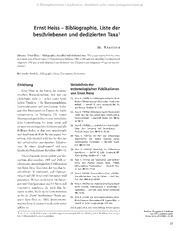
Ernst Heiss - Bibliographie, Liste der beschriebenen und dedizierten Taxa1
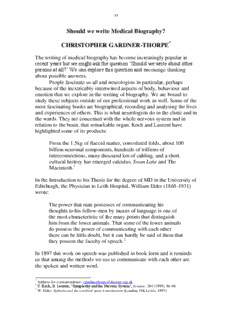
by Christopher Gardner-Thorpe. Page 55 - Evolve360

Plan 2 CS Generator
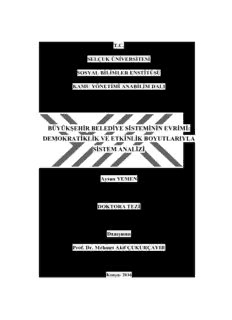
büyükşehir belediye sisteminin evrimi

Applied Reinforcement Learning with Python: With OpenAI Gym, Tensorflow, and Keras
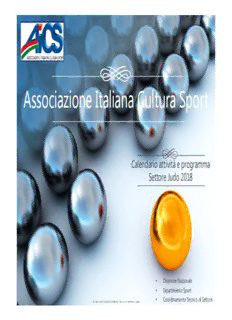
Calendario attività_programma_regolamento settore Judo Aics 2018
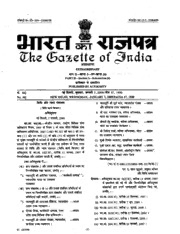
Extraordinary Gazette of India, 2009, No. 118
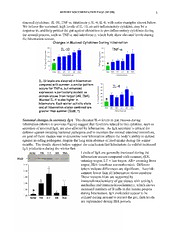
DTIC ADA442363: The Adaptive Response to Intestinal Oxidative Stress in Mammalian Hibernation

Werwolves by Elliott O'Donnell
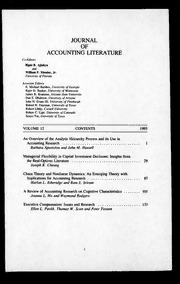
Journal of Accounting Literature 1993: Vol 12 Table of Contents
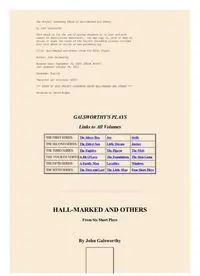
Hallmarked and Others by John Galsworthy
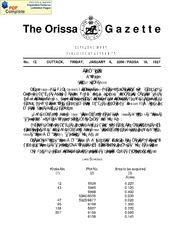
Odisha Gazette, 2005-12-27, No. 12
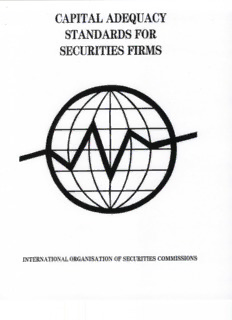
Capital Adequacy Standards for Securities Firms - International
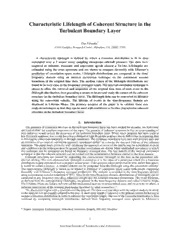
NASA Technical Reports Server (NTRS) 20060020753: Characteristic Lifelength of Coherent Structure in the Turbulent Boundary Layer
